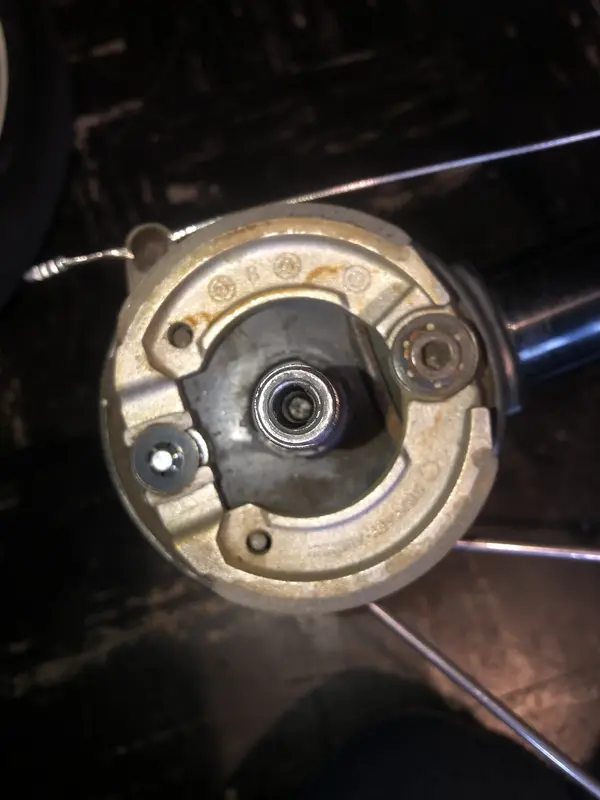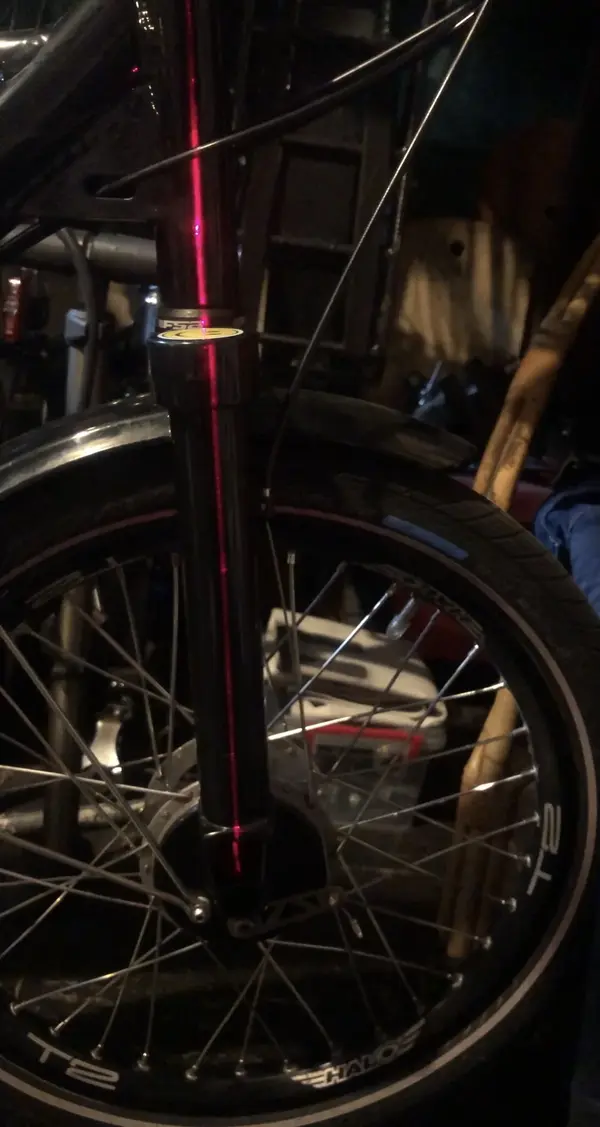You are using an out of date browser. It may not display this or other websites correctly.
You should upgrade or use an alternative browser.
You should upgrade or use an alternative browser.
8Freight Cargo bike - restoration / project
- Thread starter Joe_Rides
- Start date
Aech
GT Fan
Yes I have and I gave you two possible ways to determine the correct way the fork is designed to be mounted, i.e. on the left or on the right.Hi Aech, interesting stuff about trailing edges etc.. but have you not noticed with all the different pictures of these things, that some have the fork on the right, some on the left!? Even models that appear the same, have pics with different orients
For example if the hub retaining bolt tightens the opposite way to the forward rotation of the front wheel then there is a chance it could slacken off as you ride the bike.
Old cars had left hand thread wheel nuts on one side of the car and normal right hand thread nuts on the other, so the normal forward rotation of the wheels tended to tighten the nuts rather undo them. It's a basic safety concept, since it's better to struggle to undo your wheel nuts later on due to them self tightening rather than your wheels falling off as you drive down the road.
Modern cars have long since given up on this as metallurgy has improved so that the nuts can be torqued up enough to prevent them working loose.
Last edited:
All interesting stuff, but the easiest method to determine which side the fork should be is to just look at the direction of the mudguard mounts on the fork 
There is also a tiny bit of offset in the fork crown, so you will know if the fork is back to front! In a strange way it probably would not make a huge difference to the way in which the bike rides, as MB intended to have the head tube very steep - he wanted the handling to be lively up front to compensate for the length of the bike (turning circle is still interesting though!).
The front wheel mounting bolts all tighten clockwise,. The wheel spins on a solid internal threaded axle, similar to a bottom bracket. One end is cast permanently into the fork dropout. Therefore the wheel rotation doesn't affect the wheel bolts, although they can still loosen a little over time! A dab of low strength loctite is your friend.
@Taonut pleased you're liking your 8F by the way. Yours is a later Taiwanese made model, you can tell straight away as the basket tubing is heavier gauge, in fact they pretty much ironed out all of the problem areas of the hand built bikes made over here. It also has sensible things like cable mounts!
There is also a tiny bit of offset in the fork crown, so you will know if the fork is back to front! In a strange way it probably would not make a huge difference to the way in which the bike rides, as MB intended to have the head tube very steep - he wanted the handling to be lively up front to compensate for the length of the bike (turning circle is still interesting though!).
The front wheel mounting bolts all tighten clockwise,. The wheel spins on a solid internal threaded axle, similar to a bottom bracket. One end is cast permanently into the fork dropout. Therefore the wheel rotation doesn't affect the wheel bolts, although they can still loosen a little over time! A dab of low strength loctite is your friend.
@Taonut pleased you're liking your 8F by the way. Yours is a later Taiwanese made model, you can tell straight away as the basket tubing is heavier gauge, in fact they pretty much ironed out all of the problem areas of the hand built bikes made over here. It also has sensible things like cable mounts!
Last edited:
All interesting stuff, but the easiest method to determine which side the fork should be is to just look at the direction of the mudguard mounts on the fork
There is also a tiny bit of offset in the fork crown, so you will know if the fork is back to front! In a strange way it probably would not make a huge difference to the way in which the bike rides, as MB intended to have the head tube very steep - he wanted the handling to be lively up front to compensate for the length of the bike (turning circle is still interesting though!).
The front wheel mounting bolts all tighten clockwise,. The wheel spins on a solid internal threaded axle, similar to a bottom bracket. One end is cast permanently into the fork dropout. Therefore the wheel rotation doesn't affect the wheel bolts, although they can still loosen a little over time! A dab of low strength loctite is your friend.
@Taonut pleased you're liking your 8F by the way. Yours is a later Taiwanese made model, you can tell straight away as the basket tubing is heavier gauge, in fact they pretty much ironed out all of the problem areas of the hand built bikes made over here. It also has sensible things like cable mounts!
Thanks for reply, love that, ‘look at where the mudguard mount is’
As to the slight rake in the fork, definitely not seeing one, even with a straight edge!?
And to be clear.. this was never a problem I had.. it was more a question out of curt, as to why all pictures I’ve seen of these are either lefties or righties!? Even on similar looking models.. one left, one right
Ian’s yes.. spot on with the Taiwan … had a sticker on its belly
Thoughts!?Yes I have and I gave you two possible ways to determine the correct way the fork is designed to be mounted, i.e. on the left or on the right.
For example if the hub retaining bolt tightens the opposite way to the forward rotation of the front wheel then there is a chance it could slacken off as you ride the bike.
Old cars had left hand thread wheel nuts on one side of the car and normal right hand thread nuts on the other, so the normal forward rotation of the wheels tended to tighten the nuts rather undo them. It's a basic safety concept, since it's better to struggle to undo your wheel nuts later on due to them self tightening rather than your wheels falling off as you drive down the road.
Modern cars have long since given up on this as metallurgy has improved so that the nuts can be torqued up enough to prevent them working loose.

Regarding leading or trailing edges!?Thoughts!?
View attachment 858128
Aech
GT Fan
Looks like a standard drum brake setup, i.e. one leading & one trailing so it gives no clue as to preferred wheel rotation.Regarding leading or trailing edges!?
When you apply the brake it rotates the lever on the left hand pivot that spreads that end of the brake shoes, If we assuming clockwise rotation then the top shoe would be the leading shoe because it's leading edge of the shoe moves to touch the drum, then the drag from the drum helps dig that brake shoe into the drum magnifying the effectiveness.
The other shoe works the opposite way and the drum's rotation hinders the force it can generate because it's tending to push the shoe off, there is nothing inherently wrong with this setup it's just a twin leading shoe setup generates more braking force for the same effort applied by the rider.
Had to share this with you. I have a laser edge and checked for rake.. was really hard taking the pic and keeping everything lined up, but there’s definitely no offset on these forks!?! I’m starting to wonder if this is why there’s so many people with ‘either way’ forks! Could it possibly be a secret Burrows invention to get even wear on ya brake pads!?All interesting stuff, but the easiest method to determine which side the fork should be is to just look at the direction of the mudguard mounts on the fork
There is also a tiny bit of offset in the fork crown, so you will know if the fork is back to front! In a strange way it probably would not make a huge difference to the way in which the bike rides, as MB intended to have the head tube very steep - he wanted the handling to be lively up front to compensate for the length of the bike (turning circle is still interesting though!).
The front wheel mounting bolts all tighten clockwise,. The wheel spins on a solid internal threaded axle, similar to a bottom bracket. One end is cast permanently into the fork dropout. Therefore the wheel rotation doesn't affect the wheel bolts, although they can still loosen a little over time! A dab of low strength loctite is your friend.
@Taonut pleased you're liking your 8F by the way. Yours is a later Taiwanese made model, you can tell straight away as the basket tubing is heavier gauge, in fact they pretty much ironed out all of the problem areas of the hand built bikes made over here. It also has sensible things like cable mounts
Hi Mynchiboy,All interesting stuff, but the easiest method to determine which side the fork should be is to just look at the direction of the mudguard mounts on the fork
There is also a tiny bit of offset in the fork crown, so you will know if the fork is back to front! In a strange way it probably would not make a huge difference to the way in which the bike rides, as MB intended to have the head tube very steep - he wanted the handling to be lively up front to compensate for the length of the bike (turning circle is still interesting though!).
The front wheel mounting bolts all tighten clockwise,. The wheel spins on a solid internal threaded axle, similar to a bottom bracket. One end is cast permanently into the fork dropout. Therefore the wheel rotation doesn't affect the wheel bolts, although they can still loosen a little over time! A dab of low strength loctite is your friend.
@Taonut pleased you're liking your 8F by the way. Yours is a later Taiwanese made model, you can tell straight away as the basket tubing is heavier gauge, in fact they pretty much ironed out all of the problem areas of the hand built bikes made over here. It also has sensible things like cable mounts!
(the pic doesn’t give enough credit to how straight it all is!)

Steelfan13
Retro Newbie
Hi there,
I've recently acquired three 8 freights that need some work. Is there a way to tell how old they are and where they were built?
I'll hopefully get some photos sorted in the next couple of weeks when I can get over to where they are stored.
I know one has had some work done with new bearings in the rear hub but, not sure about the others.
Any advice on getting them up and running would be greatly appreciated!
I've recently acquired three 8 freights that need some work. Is there a way to tell how old they are and where they were built?
I'll hopefully get some photos sorted in the next couple of weeks when I can get over to where they are stored.
I know one has had some work done with new bearings in the rear hub but, not sure about the others.
Any advice on getting them up and running would be greatly appreciated!
chickendrumsticks
Senior Retro Guru
Three! Three? Triple trouble. Look forward to seeing them.